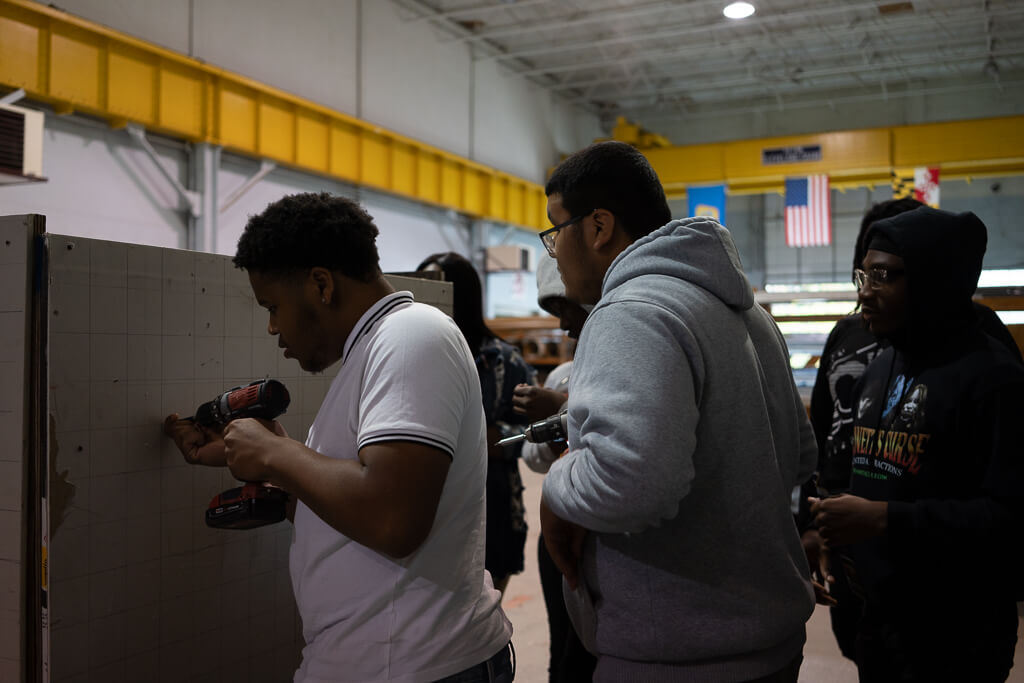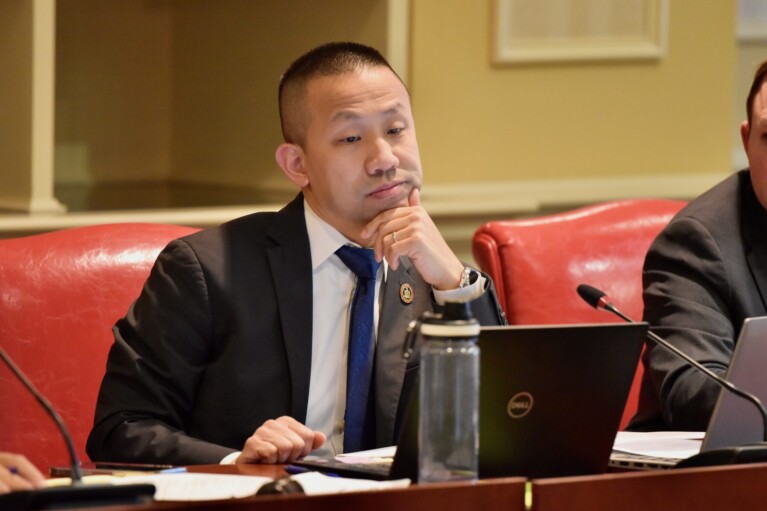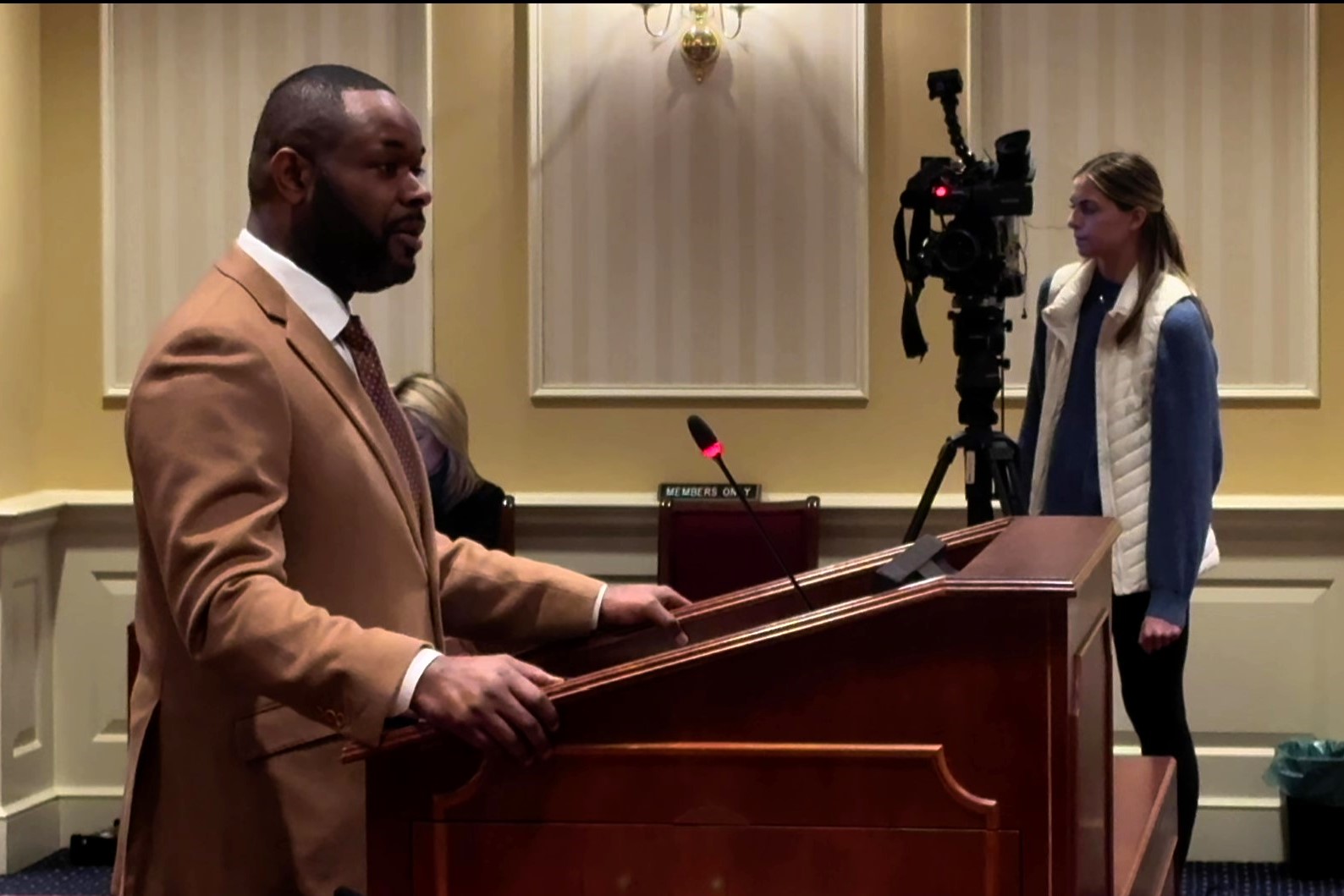
A week ago, Amarri Brown didn’t know what he wanted to do when he graduates from high school in a year.
Then on Tuesday, the 17-year-old junior at Baltimore’s City Neighbors High School took a day-long tour modeled on the college visits that countless numbers of students take each fall. But this tour for about 50 Baltimore high school students showcased apprenticeship opportunities in the building trades.
Now, Amarri is interested in becoming an electrical apprentice, following his hands-on trip to three apprentice training sites.
“I wanted a new experience, to try something new,” said Amarri, noting that he had done some carpentry before. “Electricity — I never did that before. I liked working with the wires. Now I’m interested in working with electricity. It’s dangerous, but if you know what you’re doing, it’s OK.”
Students rode two yellow buses from their schools to training centers for plumbers, electricians, and carpenters, where they tried tasks like screwing in drywall and bending conduit, the pipes through which electrical wires are run. They also sat in on training classes and labs, used an interactive machine that simulates welding, and met apprentices close to their own age, said state Sen. Cory V. McCray, (D-Baltimore City), who organized the tour as a pilot program. The goal: To teach teens who may not want to go to college about the state’s Registered Apprenticeship Program.
“Classes like shop are no longer available in high school, so as a high school student, you might not know what’s open to you in the highly-skilled trades,” said state Del. Melissa R. Wells (D-Baltimore City), who arranged lunch for the approximately 80 participants. The lunches were paid for by the Baltimore-D.C. Building Trades Union, where Wells works as a field director.
Some students were skeptical at the beginning of the tour, McCray said, but by the last stop, at the Mid-Atlantic Carpenters’ Training Center, they didn’t want to leave. Students spent about 75 minutes at each of three training centers run by the Plumbers and Steamfitters Local 486, Baltimore Electrical Joint Apprenticeship Training Committee, and Mid-Atlantic Carpenters.
Leaders could tell the teens were interested by the questions they asked. While sitting in on a class, students started with typical questions, such as what the average day on the job is like and the rate of pay, but they continued with questions that showed they were genuinely interested and thinking more deeply, said David Springham, assistant training director for the Baltimore Electrical JATC.
“They asked about the downsides, what do people say they don’t like about the job, which is not a typical question,” Springham said. “We told them to expect to be there when it’s very cold and very hot. Some asked how dangerous it is. Some asked what the requirements are scholastically.”
Some students liked the style of education.
‘You’re actually learning’
“It’s not just you sit around and listen,” said Jaheim Haynie, 17, a junior at City Neighbors. “It’s hands-on and you’re actually learning. That’s what I liked. I’m a hands-on person.”
The state’s Registered Apprenticeship program aims to help employers stymied by labor shortages to find and train qualified employees, while offering workers 18 or older an alternative pathway to college. Each step is clearly laid out, including required classes and scheduled pay raises. Registered apprentices complete up to 3,000 hours of job-related training while working full-time in a program of one to four years created by the employer and approved by the state in a program whose slogan is “earn while you learn.”
Bashan Evans, 17, knows he doesn’t want to go to college after he graduates from City Neighbors next spring, and was excited to learn about electrical apprenticeships. While some students got to speak with apprentices, Bashan did not. He recommends that all students have a chance to ask workers more about their experiences in the future.
Organizers tried to give students the chance to ask questions of apprentices for that very reason, said Neil Wilford, training director of the Baltimore Electrical JATC.
“A kid in high school doesn’t want to hear an old man nearing retirement tell them what to do,” Wilford said. “When they come here and see kids their own age tell them, ‘This is something you should think about,’ it sinks in better.”
Wells was encouraged to see the group included about four girls, and that a female carpenters’ apprentice showed students how to use a power drill.
“It’s a challenge to recruit [to the construction trades], especially to recruit young women,” Wells said. “One of the best ways to get more women is to have women there for them to see.”
The buses were paid for by CollegeBound, which works in 21 Baltimore public high schools to help students pursue post-high school education. CollegeBound hosts about two dozen college tours every year, so it was within the budget to provide buses for the Apprenticeship Tour, said Jimmy Tadlock, program director.
While CollegeBound sponsors college fairs, classroom presentations about college application fee waivers and financial aid, and otherwise supports students in Baltimore schools learn about college, many students are interested in options other than college, Tadlock said.
“Some of our students aspire to do something related to post-secondary credentialing programs. Our team makes a big difference in helping students do something post-high school, which is how the Apprenticeship Program fits in.”
McCray described the tour as a pilot that he hopes will continue. CollegeBound would like to expand the Apprenticeship Tour to include more students in the future, Tadlock said.
An electrician, McCray is a long-time advocate of apprenticeships: His own rocky high school performance turned around after he entered an apprentice program.
“The only grade I ever failed was 12th grade,” he said. In order to graduate the next year, he entered a three-year carpentry apprenticeship program, then followed with another three years as an electrical apprentice. He later paid his own way through five years of community college and the National Labor College, earning his bachelor’s degree.
McCray said graduates of Baltimore City schools earn less than $30,000 on average, while electrical apprentices can start at $12 an hour and rise to $18 an hour by their third year, eventually earning more than $30 an hour, plus health insurance, a pension, and more.
But many 18- to 20-year-olds feel unprepared to investigate careers when they don’t understand the process, and they might choose the easier route of fast food or other minimum wage jobs, he said. This is an attempt to make students more comfortable and the situation feel more familiar.
Said Bashan: “It was a great experience for people my age.”
Lisa Nevans Locke is a freelance writer who has covered education, local and federal government, and other issues in the region for more than 25 years. She has written for The Washington Times, Bethesda Magazine, Scholastic.com, The74million.org and the now-extinct Montgomery Journal, and she teaches writing at Montgomery College.
She can be reached at [email protected].



 Creative Commons Attribution
Creative Commons Attribution